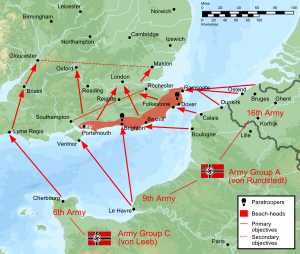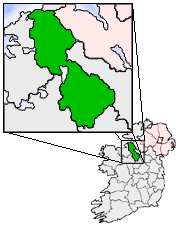Plan W facts for kids
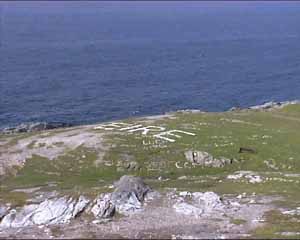
Plan W was a secret agreement between Ireland and the United Kingdom during World War II. It was created between 1940 and 1942. The plan was designed to help Ireland if Nazi Germany tried to invade it.
Even though Ireland was officially neutral, Britain worried about a German invasion. Germany had quickly defeated many countries like Poland and France. Britain knew Germany planned to invade them (Operation Sea Lion). They also thought Germany might invade Ireland (Operation Green). If Germany took Ireland, it would be a big problem for Britain. German planes could use Ireland as a base. This would make it harder for Britain to protect its ships in the Battle of the Atlantic.
Working together was tricky for both sides. Many Irish leaders had fought against the British in the Irish War of Independence (1919-1921). But the danger of a German invasion was serious. Ireland had important ports that Germany would want. So, Plan W was developed. The plan said that British troops from Northern Ireland would cross the border. They would help fight off any German invaders, especially paratroopers. The Royal Air Force and Royal Navy also had roles to play. The British would only come if the Irish government asked them.
By 1941, British military leaders thought Germany might land troops along half of Ireland's coast. They thought places like County Cork, Limerick, Waterford, Westport, Galway, Sligo, and County Donegal were possible targets. British soldiers even secretly gathered information about Ireland's railway system.
Contents
Why Plan W Was Needed
The World War II Situation
Britain had been thinking about a possible German invasion of Ireland since 1939. By June 1940, Germany's army seemed unstoppable. They had quickly defeated Poland, the Low Countries, and France. British troops had to retreat from Dunkirk. Britain believed Germany's next target would be them, in an attack called Operation Sea Lion. They also suspected Germany had a plan to invade neutral Ireland, called Operation Green.
Because of this threat, Britain and Ireland started planning together. This was difficult because of their past. Many Irish politicians had fought against the British for Ireland's independence. For example, Éamon de Valera, the Irish leader, had been active against the British. On the British side, Winston Churchill had opposed Irish independence.
However, de Valera had thought about working with Britain before. In 1921, he suggested that Ireland could work with Britain on defense in certain situations. He knew Britain worried about attacks from the west.
Britain's Worries About Ireland
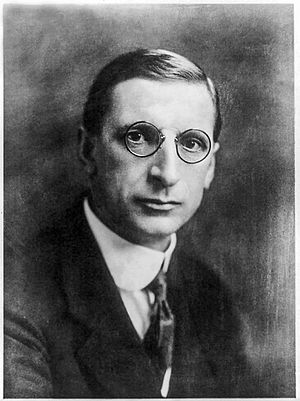
After Germany invaded Belgium and the Netherlands, Britain was sure that any invasion of Ireland would involve paratroopers. They were not confident in Ireland's ability to defend itself against airborne attacks. Taking back the 26 counties of Ireland had been discussed in Britain since the war began. In June 1940, Britain even offered to give Northern Ireland to Ireland. This was an offer of Irish unity. It was hoped Ireland would then join the Allies. But Ireland did not take the offer seriously.
British leaders like Bernard Montgomery even planned to take control of Cork and Cobh in southern Ireland. Winston Churchill also complained that the Royal Navy could not use the three Treaty Ports in Ireland. These ports were important for protecting ships. Britain was losing many ships in the Battle of the Atlantic. Some people in Britain even suggested seizing the ports if it became necessary.
So, Plan W had two main goals:
- To create a joint plan if Ireland agreed to work with Britain.
- To have an invasion plan ready if Germany invaded Ireland and Ireland resisted British help.
Knowing About German Plans
Germany started planning Operation Green in May 1940. Britain learned about these plans around June 1940. Britain wanted to protect Ireland. If Germany captured Ireland, it would leave Britain's western side open. It would also give the German air force (Luftwaffe) a base. This base could be used for attacks in the Battle of the Atlantic or for invading Britain. Britain thought Germany would target Cork, especially Cork Harbour and the naval base at Cobh. This was because it was closest to German air bases in France.
Ireland's Defense Plans
Ireland also made plans to defend itself. These plans covered attacks from both Britain and Germany. The Irish Army had plans for an invasion from across the border. They prepared explosives under bridges in counties from Donegal to Louth. The first defense line was near the Ballinamore-Ballyconnell canal. The second line was the River Boyne. If a large invasion happened, the Irish army would fight a delaying action. Then, they would split into smaller groups and start guerrilla warfare against the invaders.
Detailed defense plans were made for local areas. In Cork city, Irish motor torpedo boats and large guns would fight any sea invaders. If the enemy landed, the forts and harbor would be destroyed. A ship would be sunk to block the harbor channel. The oil refinery would be set on fire. The local defense force and army would defend the city. The First Division of the army would fight in the countryside.
How Plan W Was Developed
First Meetings in 1940
The first meeting about a joint plan against a German invasion happened on May 24, 1940. It was held in London. The goal was to figure out all the ways Germany might invade Ireland. Irish and British military officers attended. The British wanted direct contact between Irish military leaders in Dublin and British leaders in Belfast.
Irish officials secretly flew to Belfast. Then, they traveled by train to Dublin. A meeting was held under the Government buildings. British General Hubert Huddleston was already ordered to send troops south from Northern Ireland to help the Irish Army if Germany invaded.
An Irish general, Daniel McKenna, told the British that their troops could not enter southern Ireland until the Germans arrived. Another Irish minister, Frank Aiken, discussed new war technology. These meetings aimed to make sure both sides understood the threat. They also showed the benefits of working together. The details would be worked out later by their armies.
On May 28, 1940, the British officer, Dudley Clarke, reported back to London. He said the Irish Army had shared all their information. In return, they asked about British troop strength in Northern Ireland. It was agreed that if Germany invaded, Ireland would ask for help from General Huddleston in Belfast. This British advance from Northern Ireland into neutral Ireland was named Plan W.
Plan W's Details
Cork was thought to be the most likely target for an invasion. This was because it was the closest land for German air bases in France. Northern Ireland would be the base for a new British force. This force would move into Ireland to fight off invaders. Troops from the 53rd Division in Belfast were ready to move. British Royal Marines were also ready to take a bridge-head in Wexford if Germans landed there.
British military leaders thought Germany could send five army divisions by sea to Ireland. But they believed only two or three would actually land. Up to 8,000 German airborne troops could be flown in. Some might even land on lakes using seaplanes.
The British attack force, the 53rd Division, would focus on the borders of Down and Armagh. Then, they would cross into Ireland and race towards Dublin. They would use three main roads. It was not clear who would be in charge of the British troops once they were in Ireland. But it was assumed Britain would keep command.
By December 1940, the plan grew bigger. While the first British force headed for Dublin, another British division, the 61st Division, would move into County Donegal. They would secure the Treaty port of Lough Swilly for the Royal Navy. This would give Britain an important naval base they had wanted for a long time.
British war diaries mentioned that if an invasion happened, they would work closely with Irish forces. This included the Local Security Force, "if friendly." Other British documents said that if Ireland was "hostile," British signal units might take over the Irish phone system.
A secret British Army file said that British troops would not cross the border "until invited to do so by the Éire Government." But the document also noted that while most Irish people would probably help, "a small group might cause trouble" through guerrilla warfare.
Sir John Loader Maffey, the British representative in Ireland, would send a secret code word, "Pumpkins" (later "Measure"). This word would start the movement of the 53rd Division into Ireland.
Detailed plans were made in Belfast to supply the British force. Guns, ammunition, fuel, and medical supplies would be sent by train. Railway yards were expanded. Ambulance trains were ready. Coal trucks were changed into flat cars for tanks. Once the 53rd Division was in Ireland, the British planned to run 38 supply trains to Dublin every day. The Port of Belfast would handle 10,000 tons of supplies and 5,000 troops each week.
The Royal Air Force planned to send three fighter squadrons to Baldonnel Airfield near Dublin. They would also send two light bomber squadrons to Collinstown (Dublin Airport). These planes would attack German troops in Cork. British anti-aircraft guns would defend important places like the Drogheda viaduct and the airfields. The Royal Navy would tell all British and foreign ships to leave Irish ports. British submarines would patrol off Cork and the Shannon River. If an invasion happened, the Royal Navy would declare a "sink on sight" zone in the waters around Ireland.
By April 1941, the new British commander, General Sir Henry Pownall, expanded his plans. He thought German troops might land along half of Ireland's coastline. He believed Cork, Limerick, Waterford, Westport, Galway, Sligo, and Donegal were likely landing spots. British soldiers also secretly gathered information about Ireland's railway system.
Ireland's Own Planning
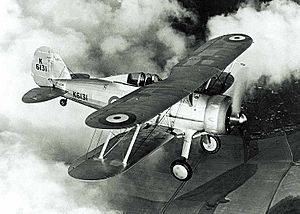
By May 1940, Irish troops were already organized to deal with parachute landings. By October 1940, Ireland had raised four more army brigades. More people were joining the Local Security Force (LSF). The Irish Army changed their German-style helmets to British-style ones. They had 16 medium armored cars and 30 light armored cars. By early 1941, Ireland had two infantry divisions ready.
The First Division was based in Cork. The Second Division was based in Dublin. There were also two independent brigades and three garrison battalions. Coastal defense forts were at Cork, Bere Island, Donegal, Shannon, and Waterford. The Irish Defence Forces were all volunteers.
If the Germans had landed where expected, the Irish Army's Fifth Brigade would have fought them first. Then, the First and Second Irish Divisions would have supported them. The British would set up their railway base near Fairyhouse race course. They would stay in places like Lusk, Howth, and Portmarnock north of Dublin.
The Irish Air Corps was small. It had nine light bombers and four Gloster Gladiator fighter planes. These were Ireland's only fighter defense. Later, they got six second-hand planes. They also repaired several Allied planes that crashed in Ireland. This added two British Hurricanes, a Fairey Battle, and an American Lockheed Hudson to their fleet. From 1942, 20 more Hurricanes joined the Irish Air Corps.
The Irish Marine Service got its first Motor Torpedo Boat in January 1940. By 1942, they had six. But their only patrol ships were two old British gunboats. They also had one "mine planter" and a barge. The Marine Service did not get any other ships during the war.
The Local Security Force (LSF) was meant to slow down enemy forces. They would blow up bridges (which were already set up for this). They would also organize small ambushes and sniping attacks. At first, they had few weapons, often using shotguns. But from 1941, they got American rifles. In January 1941, the LSF split into two groups. The 'A' force became the Local Defence Force (LDF) under military control. The 'B' group stayed as the LSF, acting as an unarmed police reserve. Younger members joined the LDF, older ones stayed with the LSF.
|
See also
- Operation Dove (Ireland)
- Operation Mainau
- Plan Kathleen


